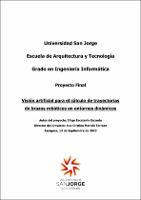Please use this identifier to cite or link to this item:
https://repositorio.usj.es/handle/123456789/980
| Title: | Visión artificial para el cálculo de trayectorias de brazos robóticos en entornos dinámicos |
| Authors: | Escalante Escarda, Iñigo |
| metadata.dc.contributor.affiliation: | Universidad San Jorge |
| Keywords: | Machine Learning; Inteligencia Artificial; Entorno; Modelo; Articulaciones; Colisiones; Entrenamiento; Artificial Intelligence; Environment; Model; Joints; Collisions; Training. |
| Issue Date: | 12-Sep-2023 |
| Abstract: | Desde el 2000 a.C., existen registros de trabajos de automatización, como la famosa Clepsidra. Actualmente existen ejemplos más complejos, como las máquinas “transfer”, que están diseñadas para la fabricación de una pieza concreta. El principal objetivo de la automatización es que un trabajo se realice con la menor interacción humana posible. En trabajos de automatización, es esencial el cálculo correcto y preciso de la trayectoria de partes móviles. Esta tarea es actualmente llevada a cabo por operarios humanos por medio de algoritmos predefinidos. El objetivo de este proyecto es preparar un entorno de entrenamiento viable para un brazo robótico. Este entorno se utilizará para estudiar si, mediante Machine Learning y el uso de Visión Artificial, se puede entrenar a un robot para realizar estas tareas. Se ha utilizado una metodología SCRUM ajustada a las necesidades del proyecto. El resultado final es un entorno preparado para cualquier entrenamiento de trayectoria de brazo robótico de 6 articulaciones (UR10e) totalmente integrado con físicas, colisiones y modelos 3D con un obstáculo cambiante para simular el entorno dinámico. Aunque los resultados del entrenamiento parecen prometedores, haría falta realizar un estudio más extenso para comprobar la viabilidad de la propuesta. El siguiente paso sería probar a entrenar con Cloud Computing y, si resulta viable, entrenar un robot para que realice cualquier tarea en el mismo escenario. |
| Description: | Since 2000 B.C., there have been records of automation put into work, like the famous Clepsydra. Nowadays, there are more complex examples like “transfer” machines, that are designed to produce a specific piece of some sort. The main objective of automation is maintaining human interaction to a minimum when working. When it comes to automation projects, it is imperative that all the calculations of the trajectories of all the mobile parts are correct and precise. This task is usually undertaken by human operators through predefined algorithms. The goal of this project is to make a training environment viable for a robot arm. This environment will be used to confirm if it’s possible to train a robot to do these calculations through Machine Learning and Artificial Vision. An adjusted version of SCRUM was the methodology used in the development of this project. The final result is a fully operational environment to train a 6 joints robot (UR10e), composed with physics, collisions and 3D models while also simulating a dynamic environment by using an ever-moving obstacle. Even though the training results seem promising, ore extensive research needs to be done to ascertain the viability of the premise. The next step would be to make use of Cloud Computing and, if it works, train a robot to do any given task in the designed scenario . |
| URI: | https://repositorio.usj.es/handle/123456789/980 |
| Appears in Collections: | Grado en Ingeniería Informática |
Files in This Item:
| File | Description | Size | Format | |
|---|---|---|---|---|
| Vision artificial para el calculo.pdf | 4,05 MB | Adobe PDF |  View/Open |
This item is licensed under a Creative Commons License

